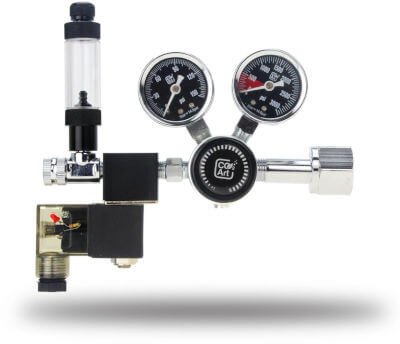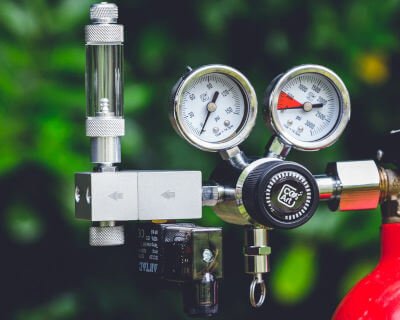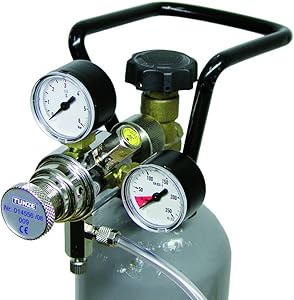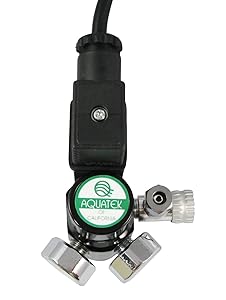Freshwater aquatic plants require the same essential nutrients as land plants.
This includes nitrogen, phosphorous, iron, and other elements.
Land plants obtain carbon by taking in carbon dioxide (CO2) from the atmosphere.
Aquatic plants need carbon too. The trouble is carbon dioxide is often lacking in the aquarium.
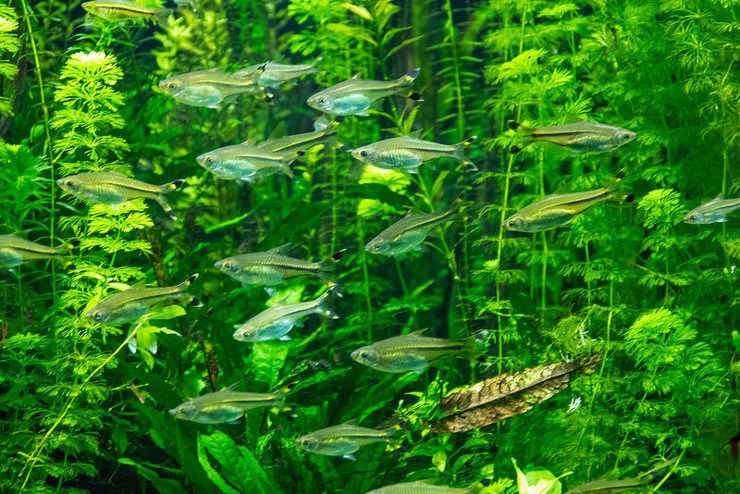
It is common for aquarium plants to become starved for carbon because our tanks are naturally low in CO2. What little carbon dioxide is present is quickly used up by the plants.
Carbon dioxide deficiency causes leaves to turn yellow, slow growth, and eventual death.
That’s why CO2 fertilization is so important.
In this article
Better plant growth means less algae
The bright lighting used on planted aquariums makes it easy for algae to take over the tank.
But when aquatic plants are thriving, algae remain under control. That’s because the plants remove nutrients and starve the algae.
However, when one of the essential nutrients is lacking, plant growth shuts down. Since CO2 is deficient, plants will be inhibited.
Liquid and tablet aquatic plant fertilizers provide minerals and trace elements, but they don’t add carbon dioxide.
Natural algae control is another reason to add CO2 to your planted aquarium.
Where to get carbon dioxide to your aquarium
The most reliable method is to inject carbon dioxide gas into the aquarium water.
You can easily find sources of CO2 gas contained in small paintball bottles or a 5 to a 10-pound CO2 tank. The small paintball bottles are perfect for nano tanks that don’t use a lot of CO2.
The small canisters are easy to refill at sporting goods stores.
The steel or aluminum tanks work best for larger tanks that require heavy CO2 fertilization. These tanks can be refilled at welding supply and beer distributors.
But how to get the gas into the aquarium water? With a CO2 regulator kit!
CO2 regulators for planted aquariums

To feed your plants carbon dioxide you’ll need a CO2 regulator kit. The regulator screws onto the CO2 tank.
It controls the pressure leaving the tank. A gauge on the regulator shows the amount of pressure inside the bottle.
The regulator reduces the pressure so you can add a small gas stream to the aquarium. The flow of gas to the aquarium is controlled with a special fine-adjustment valve.
The CO2 flows from the valve through silicone tubing and into a diffuser attached inside the aquarium. The tubing and diffuser are not usually supplied with the regulator.
You’ll need a regulator designed for aquarium use. Industrial CO2 regulators lack the fine-adjustment valve necessary to control the small volume of gas used in a planted aquarium.
You’ll run an airline hose from the regulator to a diffuser. The CO2 must diffuse into the water so it can be absorbed by the plants. A diffuser produces very tiny bubbles that help the CO2 dissolve into the water.
Some regulators come with a bubble counter that lets you see the rate of gas flow entering the aquarium. Many regulators have an electric solenoid valve allowing for automatic shut-off of gas at night.
Components of aquarium CO2 regulators:
- Threaded connector for paintball or large gas tank
- Gauges for tank and gas flow pressures
- Fine-adjustment valve
- Bubble counter
- Electric solenoid valve
Choosing a CO2 regulator for planted tanks
Ordinary industrial CO2 regulators are quite large, expensive, and unable to dial in the minute flow of gas required for planted aquariums.
Specialty aquarium regulators are economical and designed for CO2 fertilization.
Some regulators are made for large gas tanks with CGA-320 threads. Others are designed for paintball bottles.
You can use a screw-on adaptor, allowing the use of both types of gas containers.
Look for a regulator with a specialty (non-industrial) fine adjustment valve. This makes it much easier to dial-in the gas flow rate.
When choosing a regulator make note of the features we’ve discussed and see if the regulator matches up with what you need.
Here are some popular regulators to consider.
The CO2art Pro SE regulator is a two-stage unit designed for use with planted aquariums and reef aquariums. Two-stage regulators have twin-gauges. This allows you to see the pressure in the CO2 tank and the pressure being sent to the second stage.
The second stage is the pressure available at the fine-adjustment valve. The benefit of a two-stage regulator is that you can reduce the pressure coming out of the system, making it much easier to regulate the flow rate with the needle valve.
The regulator also comes with a low-voltage solenoid valve. The solenoid valve allows you to automatically turn the CO2 fertilization on and off. The valve can be switched on and off with a simple timer or an advanced automated aquarium system. The needle valve allows for very precise flow adjustments. You can make the adjustment by watching your CO2 diffuser or with the bubble counter.
The bubble counter makes it easy to see the flow rate into the aquarium because you can see each bubble rise in the counter. Many aquarists determine how many bubbles-per second or similar time frame are needed to keep the CO2 level where they want it in their aquarium.
The Pro SE regulator has a 5-year warranty.
The Pro Elite regulator can handle up to 80 psi and can run multiple manifolds. This means a single CO2 tank can provide CO2 to several aquariums. You can add up to five manifolds. The Pro-Elite regulator has a 10-year warranty.
Pros
- High-quality construction
- Good tutorial videos
- Spare parts available
- Can add extra outputs to the regulator
- Good warranty
Cons
- When using multiple manifolds, the solenoid valve turns all the CO2 outlets off, not individually.
The Fzone regulator is designed for use with paintball and regular gas canisters.
The kit includes an adapter for either type of gas container.
The single pressure gauge shows the status of the tank. A fine needle valve allows you to dial in just the right amount of gas flow. The bubble counter provides a visible indication of gas flow.
It also functions as a check valve, preventing water from back-siphoning down the airline tube. The regulator includes a 12-volt solenoid valve for controlling the system with your outlet timer.
Pros
- High-quality aluminum and stainless-steel components
- Compact size
- Easy to adjust gas flow
- Comes with adjustment tools
- Works will all types of gas containers
Cons
- None
Tunze has been manufacturing aquarium products for over forty-five years.
The Tunze Dual Gauge Regulator is designed for standard (CGA-320) CO2 tanks.
It has two gauges to show the status of the tank pressure and the lower pressure being sent to the needle valve.
The low-pressure gauge helps you adjust the regulator to lower the pressure at the valve, making it easier to make fine adjustments.
The regulator can be hand-tightened to the gas bottle without tools. It also has a built-in pressure relief valve.
The Tunze regulator is ideal for heavily-planted aquariums that use larger gas bottles. You’ll have to add your own solenoid valve if you want this feature.
Pros
- German-engineered regulator
- Dual gauges
- Fine-adjustment valve
- No tools needed
Cons
- Won’t work on paintball bottles
- Does not come with a solenoid valve
This regulator works with paintball CO2 tanks. The Mini version is equipped with high and low-pressure gauges for tank and flow monitoring.
The bubble counter allows you to see if gas is flowing. The regulator has a fine needle valve for fine-tuning the flow rate. The solenoid valve can be connected to an outlet timer to turn the system on and off.
The manufacturer suggests this regulator is best suited for smaller tanks that use the paintball bottles.
The Premium AQUATEK CO2 Regulator with Integrated Cool Touch Solenoid has all the same features but has a larger regulator but is made for standard CO2 tanks.
The AQUATEK Basic model is similar to the Premium and comes with a separate bubble counter.
The Basic and Premium regulators are suited for larger aquariums that require more CO2.
Pros
- Has dual gauges
- Comes with a solenoid valve
Cons
- Only works with paintball gas bottles
- Needle valve tends to be fragile
The ISTA regulator is a rugged all-metal CO2 system.
The regulator is made of chrome-plated metal and appears to be laboratory quality.
The dual gauges provide at a glance information on the status of the bottle pressure and output pressure.
The solenoid makes it easy to control the unit. A fine adjustment valve and bubble counter make the INSTA regulator a complete kit.
The ISTA regulator works with paintball bottles.
This small regulator is great for nano planted tanks that don’t need a large gas bottle.
Pros
- High-quality build
- Has all the features most aquarists are looking for
- Small size for nano tanks
Cons
- You will need to purchase an adapter to connect to US paintball tanks.
The S.T. International regulator is manufactured with chrome-plated metal.
It has dual gauges for monitoring pressure.
The electric solenoid valve will turn the gas on and off with your timer. This regulator has a standard industrial fine control valve for flow adjustment.
The regulator comes with a paintball bottle adaptor.
This regulator is best used on small nano aquariums that rely on small paintball CO2 bottles.
Pros
- Dual gauges
- Well-made
- Includes adapter for US paintball bottles
Cons
- Does not have a bubble counter
- Fine-adjustment valve is difficult to adjust
- No check valve
Recommendations
While all of these regulators provide a way to use CO2, a few stand out from the rest.
The Fzone Triple Stage with DC solenoid and bubble Counter has all the features needed to fertilize your planted aquarium.
The regulator has an adapter allowing it to be used on standard and paintball gas bottles. The fine-adjustment valve is made to adjust gas flow down to small quantities without a lot of adjusting.
If you plan on using a large CO2 gas bottle and don’t need a solenoid valve, consider the Tunze CO2 Dual Gauge Regulator.
It has a purpose-built fine adjustment valve and a rugged lab-quality build. You can add your own bubble counter and other accessories for a custom build.
If you have any questions or comments, please add them below!
